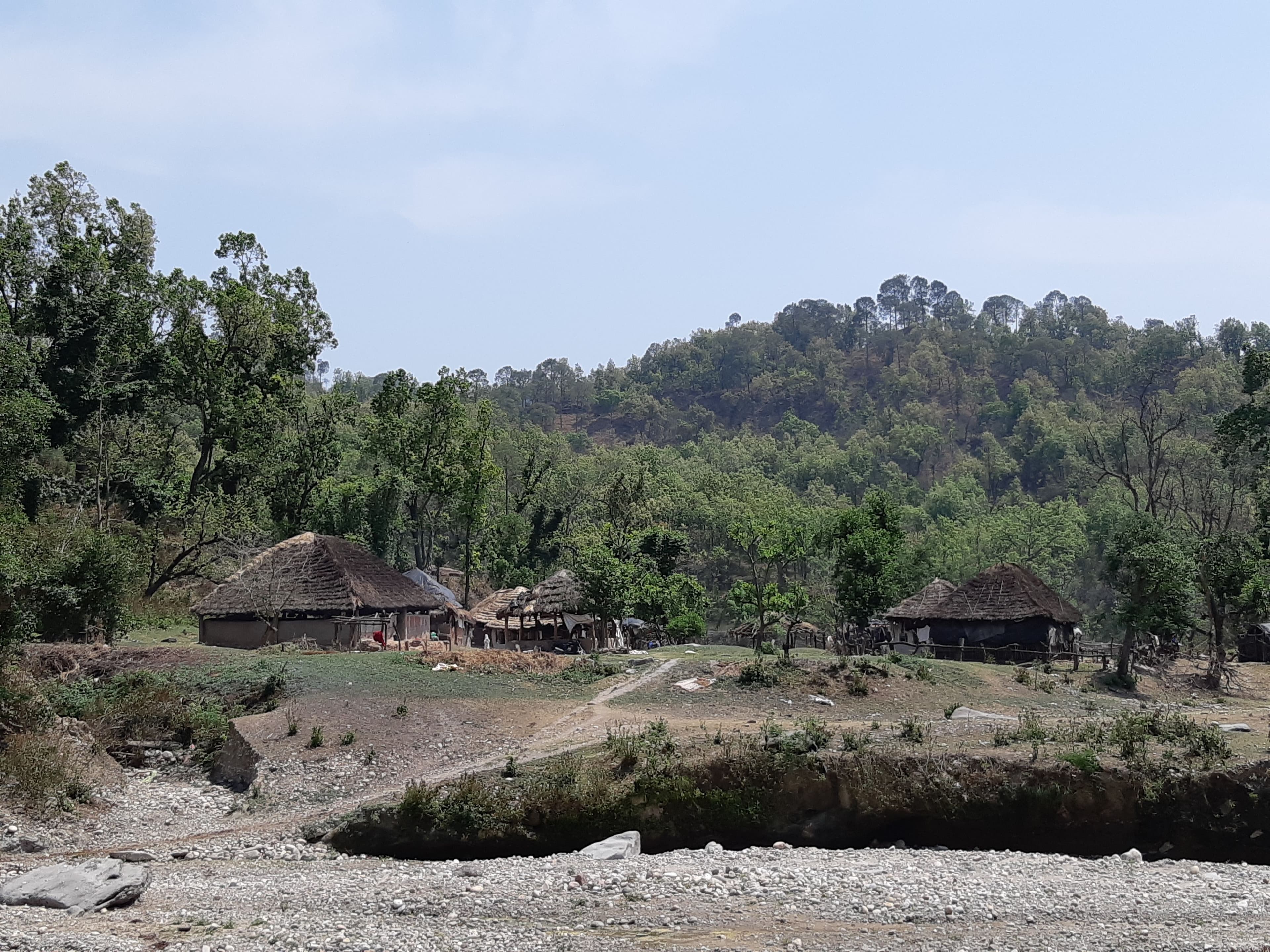We fan off the heat, waiting for the heavy summer sun to dip in the horizon, watching sparrows swoop and nest in the grass-thatched roof above. As dusk finally falls, Meer takes a small curved blade, and we walk towards the edge of the jungle. Drowsy from tea creamy with buffalo milk, I watch astonished as Meer quickly climbs the tall slender trunk like a ladder, carefully cutting specific branches for his herd.
Spread across these jungled slopes extending from the Himalayas are Van Gujjars, a semi-nomadic pastoralist community with whom I spent two months living and learning in 2019. Narratives of ill-health occur simultaneously among both people and plants in the Shivalik jungles of northern India. According to Hsu and Harris (2010), we often encounter ethnobotanical information presented outside of its socially situated context. Yet, knowledge of ecosystems and plants is highly situational. They ask: how are bodies sensitised to feel in culturally specific ways? This is significant to consider for Van Gujjars, who were embedded in the Shivaliks—a mountain range of the outer Himalayas—and reliant on this space for their livelihood, before being evicted for the creation of a national park. To carry Hsu and Harris' trajectory further, human beings are perhaps not the only organisms that can 'feel' in situationally specific ways. What happens when Indigenous peoples are forcibly alienated from culturally-salient landscapes? The social context of evictions for conservation in the Shivaliks impacts how both people and plants 'feel' wellness. A drastic decrease in people-plant encounters is voiced as a cause of illness among the community as a whole: for the jungle's biodiversity and resistance to seasonal fires, and also for Van Gujjars' physical health and ability to use traditional medicines.
For the centuries that the Van Gujjars have tied their existence to the Shivaliks in Uttar Pradesh and Uttarakhand, the jungle slopes have been anthropogenic forests. Anthropogenic forests are landscapes which are altered through human interference, often into more bio-culturally rich domains (e.g., Balée 1993). Van Gujjars lop, prune, weed, and plant specific tree and shrub varietals. As buffalo herders, the quality of, and access to, fodder is a primary livelihood concern. This relationship of care reflects an ethos of responsibility for lifeforms that provide for the needs of humans, and a recognition that these lifeforms are sentient, requiring reciprocity in return for their generosity (Turner 2020: 9). Buffaloes feast on leafy branches carefully pruned by Van Gujjars, transforming countless generations of care for the land into a nutritious meal for all. The health of the biological world around them directly impacts Van Gujjars' ability to produce milk products for their own consumption, sale, and wellbeing. We should consider Van Gujjar social-ecological emplacement within the jungle, and the many species with whom they form relations, when thinking through illness etiology in this context.

This symbiotic relationship was first threatened in the 1980s, when over 800 square kilometres were demarcated as inviolate park space (Gooch 1998; Fanari 2019). The 'parks without people' paradigm (Adams and Hutton 2007) slated the eviction of all Van Gujjars, a common threat for traditional forest-dwellers across India (see Asher 2018; EJ Atlas). Many Van Gujjars left willingly with the promise of compensation, while some were violently forced to leave as their dwellings were burned. This loss of control and freedom of movement has altered typical patterns of people-plant relations. For one, lopping trees like Meer does has been banned nearly everywhere in Uttarakhand, and often must be conducted covertly with the risk of a fine.
Plants, too, suffer from Van Gujjars' eviction from the jungle-scape. Both humans and plants feel dryness, crowdedness, and neglect. Driving along the outskirts of the park, clouds of dust billow from the highway, stretching out into dry, open farming settlements, a stark contrast to the tangled jungle. Urban amenities may be in reach, but as one Van Gujjar said, "our greatest loss is that we've been thrown far away from the jungle, the jungle that is ours, we have an attachment to it." There is hostile attention to the Van Gujjars' predicament from the state and central government such as lack of compensation, unjust criminalisation, and little access to services. The jungle also feels neglect and suffers from a national park void of people: trees that are not lopped are "drying from the inside," as one Van Gujjar described to me, making them susceptible to fire or breaking in monsoon storms.
Plantation mono-cropping implemented by the government replaced the care of Van Gujjars who used to encourage the growth of important species such as khair (Senegalia catechu), sheesham (Dalbergia sisso), and bhabar grass used for thatch (Eulaliopsis binata). Invasive species such as lantana are replacing these 'useful' ones. Increasing undergrowth from a lack of Van Gujjars' lopping and grazing exacerbates dryness and increases the scope of seasonal wildfires. Van Gujjars are no longer able to monitor fires and plant growth in their daily interactions. As I was told, "when we were residing in the forest, forest fires were less frequent. Because of less forest fires, young plants would get a chance to grow old. Today's situation is that... new saplings are also not able to survive because of more frequent forest fires." These ecosystem transformations from evictions are detrimental for plants, and also for Van Gujjars' wellbeing.
How does removal from the jungle influence Van Gujjars' perceptions of illness etiology? Prior to evictions, diets were focused on grass-fed milk and wild, foraged food (for both buffaloes and people). Cures for illness and injuries also used to be found within the forest. Today, some people complain of a decreased potency of these remedies because of poor soil quality as more communities move to peri-urban agricultural communities: "[I] used to use some herbs for ailments, for example lasoda [Cordia myxa, to make tea], which used to bring respite but not anymore. We use too much fertilizer now so these things have less effect."
Plant populations in specific geographic regions contain potent medicinal properties, particularly in higher altitudes where exposure to ultraviolet light increases anti-oxidant properties (McCune and Cuerrier 2020: 153). The traditional movement of Van Gujjars through parks to these alpine regions—a favourite spot to harvest medicine—has been restricted by state-centric conservation. Without communities being situated among plants, knowledge of the uses of medicinal leaves, barks, and roots has decreased.
Loss of physical modes of moving through jungle space also affects circulatory and muscular health. Sitting amidst packages of commercial fodder in the city outskirts, one uncle gestured towards the looming stone wall that physically separated the Van Gujjar settlement for the jungle: "We used to go running and walking to the hills, but now living in plains and all kinds of diseases happen to us."

Van Gujjars’ wellbeing is closely intertwined with encountering plants on a daily basis—through food, medicine, collecting fodder, and nurturing key species. The health of the forest also relies on these encounters. To the families I shared conversations with, wellbeing suffered due to their absence and a lack of care on the part of state resource managers. There is ample scope to consider how those plants contribute to peoples’ wellbeing, and conversely how people contribute to plants’ wellbeing. Narratives of health are not disconnected from narratives of ecology. As explored by Turner (2020) and Kimmerer (2013), plants are not important solely for their intrinsic value to nature, but are deeply embedded in reciprocal relations, a realisation which opens a space to consider Indigenous peoples’ rights to place. Restricting the Van Gujjars’ relationship with the plants and trees of the Shivaliks is catastrophic for all lifeforms in a way that monetary compensation cannot amend. Instead, we should “imagine a different relationship in which people and land are good medicine for each other” (Kimmerer 2013: x).
